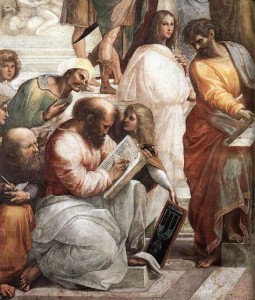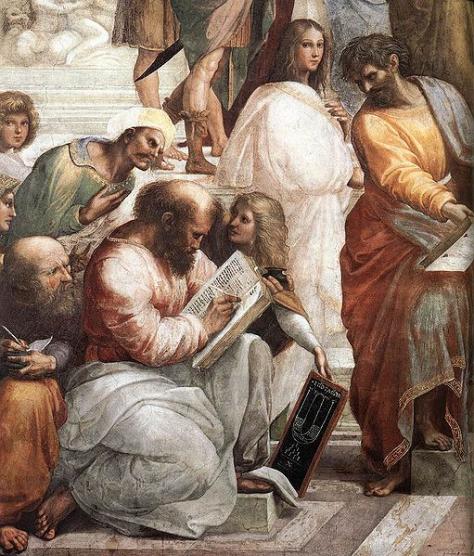
The time preceding the birth of Pythagoras is marked by preternatural light, for a legend propagated by the islanders of Samos centuries beforehand spoke of the coming of a God-son who’d succeed in gaining knowledge of the Divine or the One through the Intellect, an evolutionary step away from jungle instinct and into mystical contemplation which would benefit the whole of mankind. It is believed that even the Delphic Bee, the Pythia, had foreseen his divine birth. When the father and mother of Pythagoras, Mnesarchus and Parthenis, consulted the Oracle on matters concerning travel to Syria, the ‘voice of Apollo’ disregarded the question posed and instead spoke of the far-reaching consequences that would ensue as a result of the beauty and wisdom of their soon to be born son.
When it comes to the great thinkers of this world, it can sometimes be excruciatingly difficult to separate legend from history, fact from fiction. More often than not, we find that they are apotheosised after their deaths, raised to a status above that of other mere mortals. But Pythagoras differs in that he seemed to enjoy this luxury whilst he was still alive. A great many sources claim that he was a brute of a specimen: he was significantly tall and imposing, and unlike other men, his masculine energy, personal magnetism and physical prowess appeared to increase rather than diminish with time. These virtues were well balanced by a cultivated psyche, an ingenious mind and a nifty, outspoken tongue that attracted to itself either the reverence and awe, or the enmity and jealousy of its subjects.
I suppose his disposition was such that it served as a breeding ground for all sorts of interesting superstitions about him. Many believed that he was immaculately conceived, that he had a golden thigh and that he was attuned to the “Music of the Spheres”, the harmonic sounds that issued from the planetary spheres as they traversed the heavens. Others went further by asserting that he possessed magical or hypnotic powers. Merely by thinking it, Pythagoras could cause a flock of birds to change their migratory path, tame a wild animal such as a boar or wolf, cause change in the habitual diet of all any creature and attract to himself the affinity of a white eagle. Even the elements were subject to his mighty will. He could call forth spirits inhabiting other dimensions to cause ripples or vibrations on the surface of a pond. One time, his meditative prayer to a water spirit was actually answered with the words, “Pythagoras, I greet thee.” The god-like image and powers of Pythagoras, built upon centuries of worship, is reminiscent of a Middle Age genius in the physician and alchemist Paracelsus of Hohenheim. Like the former, Paracelsus was alleged to have traversed Europe astride a beautiful white horse, to have regained his youth by sealing a Faustian pact with malevolent demons and to have stored ample amounts of the ruby red Philosophers Stone, or the Elixir of Life, inside the pommel of his sword. Stranger still, many residents of Salzburg claim that he had returned from the dead on numerous occasions to bequeath cures for certain untreatable conditions and diseases. All too often we find that the propensity of the human imagination to idolise and worship renders myth and legend far more memorable than the actual lifetime achievements of the man or woman in question.
The legends no doubt confer something of a superhuman aura, a man who understood the fundamental unity, mechanics and the harmonic arrangement of matter in the cosmos and used divination as to demonstrate its occult principles. But before we go on to examine Pythagoras’s original contributions to the growing pool of knowledge, it is important to scour his life and discern what may have been borrowed from three other primordial civilisations which lay to the south and east of Greece, intellectual property which he no doubt would have presented as his own upon establishing his own secret and esoteric school in Crotona, a Hellenic settlement in Italy.
We know that he was born in the early decades of the sixth century BCE, probably in 570BCE, a period in which humanity’s consciousness had ripened just enough to be receptive to the spiritual teachings dispersed in India by the Buddha, and in China by Confucius and Lao Tse. What spurred Pythagoras to travel for a good thirty-four years or so is uncertain, though it’s likely that it transpired at the bidding of Polycrates, the tyrant of Samos who took a liking to the metaphysical protégée. The latter’s alliance to Egypt proved advantageous, for it gave Pythagoras access to Egyptian esoteric knowledge which would have otherwise been inaccessible. Pharaoh Amasis, Egypt’s last indigenous pharaoh, facilitated a safe transfer to Thebes where he was, amongst other things, circumcised and then initiated into the Mysteries of Isis at the hands of the powerful Theban priesthood.
That the harmonic arrangements of the cosmos can be descried through mathematical formulae he would have learned from the Egyptian priests. Their “sacred science” would have remained hidden to all but those initiated into the mysteries. It was an all-encompassing science which syncretised astronomy, philosophy, mathematics, and music, and taught that all laws, principles and quantities of nature are fractions of one, the largest mathematical number. By gaining instruction in the symbolism, the placement of the bas reliefs, the measurements and proportions, and the axes and orientations of the Temple of Amun-Mut-Khonsu in Thebes, Pythagoras gained knowledge of the equation relating to the square of the hypotenuse which would later be ascribed to him as well as other mathematical formulae supporting the notion that identical laws and relationships govern both the microcosm (Man) and the macrocosm (the Cosmos). This knowledge of the geometrical governance of all of nature enabled the Egyptians to erect pyramids, obelisks and megalithic temples.
A lamentable turn of fate saw the fall of Egypt at the hands of the Persians, and Pythagoras was henceforth sent to the valley of the Euphrates, to Babylon, by the Persian king Cambyses. Whilst he was there, he was initiated into the Mesopotamian mysteries. The Persian magi unveiled the anatomy of the heavens as seen through the kaleidoscope of Chaldean astronomy. In those times, there was no distinguishable difference between astronomy and astrology, and the Chaldean school was an astro-philosophical system which aimed to chart, interpret and predict the movement of planetary bodies and constellations, assign character and behavioural traits to the latter and unite these two streams of thought as to create a mutually dependent and holistic conception of the cosmos linking the heavens above and the earth below. In this working framework, character and behavioural traits of each individual could be understood in the context of their chosen path of descent through a specific constellation at the time of their birth.
It’s worthy to note here that astrology is the most experientially viable and investigative of the esoteric traditions. Those who delve into the primordial practice, one of the first “sciences” known to man, will quickly come to conclusion that there is an uncanny truth to its predictions. I, for one, know of a great many writers, poets and playwrights born under the astrological sign of Cancer, eminent soldiers and leaders born under Sagittarius, and mathematical geniuses and quick-witted individuals born under Gemini. Anybody with a passing acquaintance with astrology will know that the character traits mentioned correspond with the nature of their ruling planets; the moon, Jupiter and Mercury, respectively.
Having penetrated into Hindustan, there can be no doubt that Pythagoras would have run into the Indian sages who contemplated Brahman via projection into the invisible realms and communion with the invisible beings that inhabit them. The doctrine of reincarnation or metempsychosis (μετεμψύχωσις) which attempts to demarcate the soul’s destiny appears to have infiltrated Pythagorean ideology towards the end of his life. Modern scholars are convinced that it was derived directly from oriental mysticism, reformulated and then regurgitated with his own philosophical bent when he began teaching his doctrines and initiating candidates into his esoteric school at Crotona.
There seems to be some confusion around what Pythagoras actually was, and how he might have identified during course of his travels and when he established himself at Crotona afterwards. While it is true that he immersed himself in mysticism and divination, his primary aim was to grasp the Prime Course, the One which pervading and infused all matter with life through intellectual contemplation. Nowadays we would argue that intellect alone cannot fully grasp the divine, for the former mimics the physical senses in that it can only give a flat, two-dimensional rendition of a multidimensional, all-encompassing and numinous providence. Nevertheless his practical and experiential approach to the intangible divine was original and unique, a method of inquiry into phenomena which he called philosophy. In fact, Pythagoras was the first man to call himself a philosopher, a word which transcribes to ‘lover of wisdom’ in Greek.
Major changes had unravelled on Samos during the years that Pythagoras was away. He returned to an island on which the repressive despotism that had rooted itself there decades before under Polycrates had grown increasingly intolerant of critical inquiry. Pythagoras cut his losses and moved to Crotona in Italy where he established Europe’s first philosophical and esoteric school. Its primary focus was to confer cosmic secrets upon those he deemed worthy and able to receive them through a three-tiered system of initiation. Neophytes were forbidden to ask questions and had to listen to discourse given by Pythagoras from behind a curtain. The grades themselves–Mathematicus, Theoreticus and Electus–each cultivated proficiency in arithmetic, geometry, music and astronomy, denominations of inquiry that formed the triangular foundation of the cosmos and instilled the individual with the requisite knowledge needed to facilitate an experience of illumination or apathanatismos (mystical communion with the divine). He imposed an obligatory oath of silence to all his students lest this powerful knowledge be misconstrued or misused by those who had neither the talent nor the moral compass for it. All esoteric and secret brotherhoods such as the Freemasons and the Rosicrucians that came afterwards varied in the style and type of rituals they employed and in the content of their teachings but all were united under the aegis of the Pythagorean veil of secrecy.









